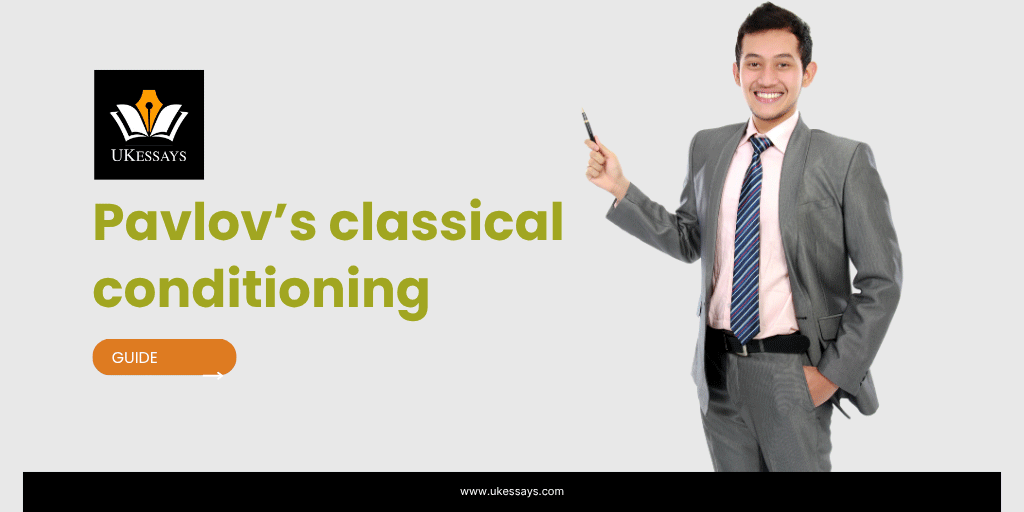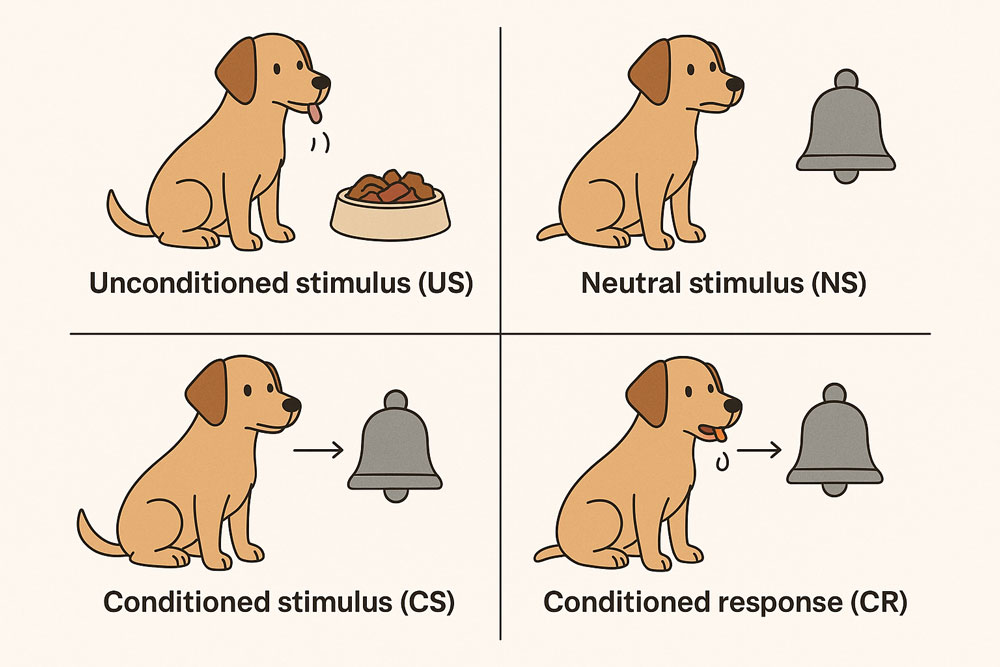Pavlov classical conditioning guide
Info: 5287 words (21 pages) Study Guides
Published: 01 Oct 2025

Psychology assignments can be complex and time-consuming – get help from a UK-qualified psychology expert now. See our psychology assignment help page for more info.
Classical conditioning (also known as Pavlovian or respondent conditioning) is a fundamental learning process based on associations between stimuli. It was first described by Ivan Pavlov in the early 20th century and has become a cornerstone of behavioural psychology (Pavlov, 1927).
In classical conditioning, an organism learns that a previously neutral stimulus predicts a significant event, so the neutral stimulus comes to elicit a response on its own.
This form of learning is often contrasted with operant conditioning (learning through consequences), but classical conditioning specifically involves reflexive or automatic responses rather than voluntary actions. It is one of the most basic ways that organisms adapt to their environment, and its principles apply to humans and other animals alike.
Historical background
Ivan Pavlov was a Russian physiologist who, somewhat unexpectedly, became one of the founding figures in psychology due to his discovery of conditioned reflexes.
In the 1890s, Pavlov was studying digestion in dogs by measuring their salivary responses to food. However, he noticed an intriguing pattern. Dogs would begin to salivate even before the food was presented – for instance, they salivated at the sight of the empty food bowl or at the sound of the lab assistant’s footsteps (Pavlov, 1927).
Pavlov referred to this anticipatory salivation as a “psychic secretion” since it occurred in response to cues associated with food rather than the food itself. This observation suggested that the dogs had learned an association between certain signals and the forthcoming delivery of food.
Pavlov rigorously investigated this phenomenon through controlled experiments. In 1903 he reported the basic learning process now called classical conditioning (Pavlov, 1927).
In one famous experiment, he repeatedly rang a bell just before giving food to his dogs. Initially, the bell was a neutral stimulus that elicited no salivation. Food, on the other hand, was an unconditioned stimulus that naturally elicited salivation (an unconditioned response). After multiple pairings of bell followed by food, the dogs began to salivate upon hearing the bell alone, even if no food was presented. The bell had become a conditioned stimulus that evoked a conditioned response (salivation) through its learned association with food.
Pavlov’s work provided the first systematic evidence of learning by association in animals. It earned him lasting fame – he was awarded the Nobel Prize in 1904 (for his earlier digestion research).
Pavlov’s discoveries soon influenced psychology at large. Pavlov’s findings inspired American psychologist John B. Watson, who saw classical conditioning as the key to explaining human behaviour. Watson’s 1913 “Behaviorist Manifesto” advocated that psychology should focus on observable stimulus–response relationships, largely dismissing unobservable mental processes (Watson, 1913).
Soon after, Watson and Rosalie Rayner demonstrated that even human emotions could be conditioned. In their controversial 1920 experiment, they conditioned an infant known as “Little Albert” to fear a white rat by pairing the rat with a loud, frightening noise (Watson & Rayner, 1920). Initially Albert had no fear of the rat. After repeated pairings with the noise, he would cry and show distress at the mere sight of the rat. Moreover, his fear generalised to other fluffy white objects, illustrating how classical conditioning could underlie phobias.
Ethics would not permit such an experiment today. However, Watson’s study with Little Albert dramatically showed that classical conditioning principles apply to humans.
Basic principles of classical conditioning
Classical conditioning is fundamentally a process of learning by association. Through this process, a neutral stimulus becomes able to elicit a response because it has been paired with a stimulus that naturally produces that response.
Pavlov’s experiments established the core terminology and sequence of events for classical conditioning. There are several key components:
- Unconditioned stimulus (US): a stimulus that naturally and automatically triggers a reflexive response without prior learning. For example, food acts as a US because it elicits salivation instinctively in a hungry animal.
- Unconditioned response (UR): the automatic, unlearned reaction to the unconditioned stimulus. In Pavlov’s paradigm, the dog’s salivation in response to food is the UR. This response is innate and requires no training.
- Neutral stimulus (NS): a stimulus that initially does not trigger the targeted response. It is “neutral” in relation to the response of interest. In Pavlov’s setup, the sound of a bell or a tone was initially an NS that caused no salivation.
- Conditioned stimulus (CS): originally the neutral stimulus, but after being paired repeatedly with the unconditioned stimulus it becomes a conditioned stimulus. The organism learns that this stimulus predicts the US. In our example, the bell sound becomes a CS once the dog has learned the bell–food association.
- Conditioned response (CR): the learned response to the conditioned stimulus, similar (or related) to the original unconditioned response. The dog’s salivation upon hearing the bell alone is a CR – a response acquired through association rather than a natural reflex to the bell.

The classical conditioning process typically unfolds in three phases:
- Before conditioning: The unconditioned stimulus reliably elicits the unconditioned response, and the neutral stimulus elicits nothing relevant. At this stage there is no learned association. For instance, before any training, food (US) produces salivation (UR) and a bell (NS) produces no special response.
- During conditioning (Acquisition): The neutral stimulus is repeatedly presented immediately before the unconditioned stimulus. Through these pairings, the association between the two stimuli is formed in the learner’s mind. Timing is important – classical conditioning is most effective when the NS slightly precedes the US, creating an expectation. Pavlov found that ringing the bell shortly before the food was given led to robust conditioning. Presenting the stimuli simultaneously or in reverse order (food then bell) was much less effective. The NS effectively becomes a signal that the US is coming. During acquisition, the conditioned response typically strengthens with each pairing of the CS and US. It eventually levels off as it approaches a maximum level. However, one-trial learning can happen in certain cases when a single intense pairing is sufficient (such as developing an aversion after one instance of severe food poisoning).
- After conditioning: The neutral stimulus is now a conditioned stimulus capable of triggering the response on its own. The organism will respond to the CS even in the absence of the US. In Pavlov’s scenario, after enough bell–food pairings, the bell sound alone causes the dog to salivate. The dog has learned the association, and a new conditioned reflex has been established.

It is important to note that the conditioned response is not always identical to the unconditioned response, even though they are usually similar. Sometimes the CR is a more preparatory or anticipatory response. For example, if a buzzer (CS) signals an upcoming mild electric shock (US) to a rat, the rat’s unconditioned response to the shock might be a brief pain reflex or startle.
By contrast, its conditioned response to the buzzer might be a very different fear-related behaviour, such as freezing. In either case, the CR occurs because the animal anticipates the US based on the CS.
Acquisition
Acquisition refers to the initial stage of learning when the association between the CS and US is being formed. Multiple factors influence how quickly and strongly conditioning occurs. The contiguity of the CS and US – meaning how closely in time they are presented – is a significant factor.
Generally, shorter intervals (with the CS appearing just before the US) lead to faster learning, so the CS is a clear predictor of the US. The sequence is critical. The conditioned stimulus generally needs to come before (or at least concurrently with) the unconditioned stimulus for learning to occur in most cases. If the CS comes after the US (backward conditioning), learning is usually weak or fails to occur at all.
Another important factor is contingency, which refers to how reliably the CS predicts the US. Modern research has shown that contingency can be even more crucial than simple contiguity. The CS must provide information that the US is likely to occur. If the US also occurs frequently without the CS, the association will be weak.
For example, Robert Rescorla’s experiments in the 1960s demonstrated that conditioning is poor when a CS is paired with a US that also happens at random times without the CS – consequently, little conditioning occurred (Rescorla, 1968). In such cases, the CS does not reliably signal the US, and animals do not develop a strong conditioned response despite repeated pairings.
This finding revealed that classical conditioning is not just a product of mechanical pairing. The learner detects causal relationships. Therefore, the CS–US pairing must be informative for learning to take place. The learning that occurs during acquisition is often interpreted as the organism learning that “CS predicts US.”
Typically, the strength of the conditioned response rises with each additional CS–US pairing. It gradually increases in magnitude until reaching a plateau (a learning asymptote). If the US is very intense or biologically significant, conditioning can occur in just one trial (Seligman, 1970). Taste-aversion learning is a prime example: a single instance of eating a novel food and then getting sick (even hours later) can make an individual avoid that food in future.
This one-shot learning does not follow the usual need for close timing or repetition. It likely occurs because organisms are evolutionarily prepared to form certain associations that are critical for survival (Garcia & Koelling, 1966). Such preparedness highlights that acquisition is not purely about repetition – the nature of the stimuli matters as well.
Extinction and spontaneous recovery
Once a conditioned response has been acquired, it can also be diminished or eliminated. Extinction in classical conditioning is the process by which the CS–US association is weakened when the CS is presented repeatedly without the US. If Pavlov kept ringing the bell but stopped providing food afterwards, the dog’s salivation to the bell would gradually decrease and eventually cease.
Extinction is not mere forgetting. It is an active learning process in which the organism learns that the conditioned stimulus no longer predicts the unconditioned stimulus (Rescorla, 1988). Over time without reinforcement, the CS loses its power to elicit the CR.
It is important to note that extinction does not erase the original learning. Evidence for this comes from spontaneous recovery. Spontaneous recovery is the reappearance of an extinguished conditioned response after a delay or rest period, without any new training. For instance, after a dog’s salivation to the bell has been extinguished, the dog might be brought back to the lab the next day and hear the bell again. Often the dog will briefly salivate again to the bell, even though the response had seemingly been eliminated the day before. This recovered response is typically weaker and can be extinguished again quickly if the CS continues to be presented without the US.
Spontaneous recovery shows that the original CS–US association is not gone. It may persist in some latent form. Therefore, extinction is better viewed as new learning (“the bell no longer predicts food”) that competes with the original conditioning, rather than unlearning of the initial association.
Generalisation and discrimination
Classical conditioning often generalises beyond the exact original conditions. Stimulus generalisation is the tendency for stimuli similar to the conditioned stimulus to also evoke the conditioned response. The organism, having learned an association involving a specific CS, responds in a similar way to stimuli that resemble that CS. Pavlov observed evidence of generalisation in his experiments.
For example, a dog conditioned to salivate to one tone would also salivate (often more weakly) to a different tone it had never heard before. Similarly, Little Albert’s fear of the white rat generalised to other white furry objects (Watson & Rayner, 1920). Generalisation is adaptive: it allows learning to be applied broadly. A wild animal that has learned to fear a lion’s roar will probably benefit from also avoiding similar growling sounds from other predators.
Discrimination, on the other hand, is the process by which an organism learns to distinguish between different stimuli, responding to some but not others. Through discrimination training, a subject can learn that only a very specific stimulus (the true CS) is followed by the US, while similar stimuli are not.
In the lab, you can train a dog to salivate to a high-pitched tone but not to a low-pitched tone by selective pairing. The high tone is presented together with food, whereas the low tone is repeatedly presented without food. Over time, the dog will salivate only to the high tone. This ability to discriminate ensures that the conditioned response is precise and not overgeneralised. Discrimination is as important as generalisation. Without it, organisms might respond the same way to all sorts of irrelevant cues.
Generalisation and discrimination are two sides of the same coin: generalisation broadens the range of stimuli that elicit a response, whereas discrimination narrows it. In real life, some balance of these processes occurs. For example, a person who was bitten by a large dog might initially fear all dogs (generalisation). Over time, they may learn to discriminate and only feel anxious around dogs that resemble the one that bit them, or only around unfamiliar large dogs rather than small ones.
Higher-order conditioning
Pavlovian conditioning can extend beyond a single CS–US relationship through higher-order conditioning (also called second-order conditioning). In higher-order conditioning, an established conditioned stimulus is used in place of an unconditioned stimulus to condition a new neutral stimulus. In other words, once a CS reliably elicits a CR, that CS can be paired with a new NS to transform the NS into another CS.
For example, suppose a dog has already learned to salivate to a feeder’s whistle because it predicts dinner (first-order conditioning). Now, every time the dog is fed, the feeder opens a particular cupboard and the door squeaks just before the whistle blows. The dog may start getting excited merely upon hearing the cupboard door squeak. In this scenario, the cupboard sound has become a second-order CS by association with the whistle. Notably, the light was never directly paired with food.
Higher-order conditioning demonstrates how complex webs of associations can form. In theory, third-order or higher conditioning could occur (using CS₂ to condition a CS₃, and so on). However, in practice the strength of conditioning tends to decrease with each level. It becomes very difficult to go beyond second-order.
Nonetheless, second-order conditioning happens in real life. A practical example can illustrate this phenomenon. Suppose a dog has already learned to salivate to a feeder’s whistle because it predicts dinner (first-order conditioning). Now, every time the dog is fed, imagine the feeder opens a particular cupboard and the door squeaks just before the whistle blows. The dog may start getting excited merely upon hearing the cupboard door squeak. In this scenario, the cupboard sound becomes a second-order CS by association with the whistle.
Cognitive and biological refinements of the theory
Classical conditioning theory has evolved since Pavlov’s time, incorporating insights from cognitive psychology and biology. Pavlov and early behaviourists viewed conditioning as an automatic, mechanical process.
However, later research revealed that there are important cognitive factors – such as the predictability and informational value of cues – and biological constraints that shape conditioning. These refinements have led to a more nuanced understanding of how classical conditioning works in different situations.
The role of expectation and contingency
Early theories assumed that the frequency and timing of CS–US pairings were the sole determinants of learning. Pavlov himself emphasised temporal contiguity (closeness in time) as critical.
However, as mentioned, Robert A. Rescorla challenged this view by showing that predictability (contingency) is key. In a classic experiment, Rescorla (1968) conditioned dogs (in other studies, rats) to a tone and shock. One group experienced shocks that occurred mostly when the tone was on, whereas another group experienced the same number of tone–shock pairings but also received extra unsignalled shocks in the intervals when the tone was off. He found that only the first group developed a strong fear response to the tone. In the second group, the tone was a poor predictor of shock because shocks also happened at random times. Consequently, the animals learned little or nothing about the tone. Therefore, the tone must provide new information about the likelihood of the shock for conditioning to take place. Pairing alone does not guarantee learning – the organism learns the relationship between events, not just a temporal association (Rescorla, 1988).
The Rescorla–Wagner model (Rescorla & Wagner, 1972) formalised this idea by suggesting that learning depends on the “surprise” – or prediction error – of the unconditioned stimulus. At the heart of this model is the notion that a CS gains associative strength only if the US is unexpected or unpredicted by existing cues. When a US is fully predicted (no surprise), there is no new learning.
A striking illustration is the blocking effect, first reported by Leon Kamin in 1969 (Kamin, 1969). In a blocking experiment, an animal is first conditioned to one CS (say a light → shock). Then a second stimulus (say a tone) is introduced in combination with the first (light + tone → shock). If the light already perfectly predicts the shock. The tone adds no new predictive value, so the animal fails to learn about the tone. The tone’s presence is “blocked” by the earlier light–shock association. When tested alone, the tone elicits little or no fear response because its pairing with shock during training did not result in additional learning.
The blocking phenomenon supported the view that animals are not passive recipients of pairings. They actively compute which stimuli are informative. Conditioning occurs only when the US is surprising or not fully expected based on current cues. This has cemented the idea that classical conditioning involves a cognitive aspect of expectation.
Furthermore, research with human participants indicates that conscious awareness can influence conditioning. In adult humans, a conditioned response often develops robustly only if the person is aware of the CS–US contingency (Lovibond & Shanks, 2002). For example, if a certain tone is paired with a mild shock, a participant who recognises that the tone predicts the shock will show a strong anticipatory response to the tone. In contrast, a participant who remains unaware of the connection will exhibit a much weaker response to the tone. Simply instructing participants that the tone will not be followed by the shock can also eliminate the conditioned response almost immediately, effectively circumventing slow extinction.
Such findings suggest that cognitive factors (beliefs, expectations, attention) can modulate classical conditioning, at least in humans with the capacity for explicit understanding. Therefore, while classical conditioning can occur without conscious deliberation (especially in animals or with very salient stimuli), in people it often interacts with cognition. Modern theories integrate these insights, viewing Pavlovian conditioning as the learning of associations that inform the organism about causal structure and allow it to anticipate important events (Rescorla, 1988).
Biological constraints and preparedness
Despite the general principles of classical conditioning being widely applicable, not all stimuli and responses are equally conditionable. Animals (including humans) come with innate predispositions that make some associations easier to learn than others. Martin Seligman coined the term “biological preparedness” to describe the tendency of organisms to form certain associations more readily due to evolution (Seligman, 1970).
A classic set of studies by John Garcia and colleagues demonstrated this principle. They showed that rats could quickly learn to associate a taste (such as sweet-tasting water) with illness. However, they had great difficulty associating a light or a tone with that same illness (Garcia & Koelling, 1966). In their experiments, rats drank sweetened water (with a distinct taste) accompanied by flashes of light and clicks (an audiovisual stimulus). One group of rats was then made ill by X-rays or a toxin after drinking, and another group received a mild electric shock to the feet immediately after drinking.
The results were striking. Rats exposed to illness later avoided the sweet taste but not the audiovisual cues. In contrast, rats exposed to shock suppressed their drinking when the lights and sounds were present, but they did not develop an aversion based on taste. In other words, the rats readily formed taste–illness associations and separate audiovisual–shock associations, but not the mismatched combinations. This selective learning makes sense from an adaptive standpoint: in nature, taste is a reliable cue for something that makes an animal sick (e.g. poisonous food), so evolution has “prepared” organisms to learn taste–illness links readily, even with long delays between eating and feeling ill. Conversely, arbitrary associations that are not ecological (like taste with shock) are not easily learned.
Preparedness is also evident in human fears and phobias. People tend to develop phobias of snakes, spiders, or heights more readily than phobias of cars, electrical outlets, or knives, even though the latter cause far more injuries in modern life. Seligman (1970) argued that humans are evolutionarily prepared to fear things that posed threats to our ancestors.
Indeed, in conditioning experiments, individuals can be more quickly conditioned to fear images of snakes or angry faces than to fear neutral or innocuous items like flowers or happy faces. This suggests a built-in bias in the learning system. Additionally, some associations are virtually impossible to create. No matter how many times one pairs a particular sound with nausea, it may never induce an aversion in the way a flavour can. Biology therefore places limits on the blank-slate idea of conditioning – the brain’s wiring influences what can be learned.
Neural and physiological research also sheds light on classical conditioning. Different brain systems are involved depending on the type of response being conditioned. For example, the cerebellum is known to be critical for delay conditioning of motor reflexes like the eye-blink response in rabbits and humans. If the cerebellum is damaged, an individual may struggle to form such simple conditioned reflexes.
Fear conditioning, on the other hand, relies on the amygdala. Rats with amygdala lesions do not develop normal fear responses to a tone paired with shock. These findings align with the notion that classical conditioning isn’t a single, monolithic process – it taps into various innate response systems and neural circuits.
Applications of classical conditioning
Classical conditioning is not only a theoretical construct confined to laboratories – it has many practical applications in daily life and various professional fields. Because it addresses how organisms learn automatic reactions to stimuli, it plays a role in emotional responses, habits, and even physiological processes.
Clinical therapy and behaviour modification
One of the most significant uses of classical conditioning principles is in the treatment of anxiety disorders and phobias. If a phobia is essentially a classically conditioned fear (as in the Little Albert example), then by the same logic it should be possible to unlearn that fear or replace it with a new response.
Therapies based on conditioning have indeed been very effective. Exposure therapy, for example, is fundamentally an extinction procedure. A person with a phobia (say of dogs) is gradually and systematically exposed to the feared stimulus (a dog) without any bad outcome, in a controlled and safe environment. Over repeated exposures, the conditioned fear response diminishes. The patient learns that the cue is no longer followed by anything harmful. As a result, the fear response to the cue is weakened or eliminated. This process is classical extinction applied therapeutically.
A related technique, systematic desensitisation, was introduced in the 1950s by Joseph Wolpe specifically to treat phobias using conditioning principles (Wolpe, 1958). In systematic desensitisation, the patient is first trained in deep relaxation techniques. Then, while relaxed, the patient is gradually exposed to a hierarchy of feared situations, from least frightening to most frightening. The relaxation response is intended to inhibit the fear response – essentially counter-conditioning the anxiety.
Because relaxation is incompatible with fear, the feared stimulus comes to elicit calm instead of panic. For instance, a person afraid of flying might initially practice relaxation while simply imagining an airplane. Gradually, they can progress to sitting in a stationary plane, and ultimately to taking a short flight – all while using the learned relaxation techniques. Through this gradual process, the previously fear-evoking cues lose their power to trigger anxiety. This approach has been highly successful for many individuals with phobias and related anxiety disorders.
Classical conditioning principles also underlie aversion therapy, a treatment approach for certain unwanted behaviours such as alcoholism or smoking. In aversion therapy, the maladaptive behaviour is paired with an unpleasant unconditioned stimulus in order to condition an aversive reaction to the cues associated with the behaviour.
For example, a medication like disulfiram (Antabuse) causes nausea and vomiting when alcohol is consumed. If a patient on Antabuse drinks alcohol (US = chemical causing sickness), they experience intense nausea (UR). Over time, the taste and smell of alcohol – or even the thought of drinking – become associated with this very unpleasant effect. As a result, they start to elicit feelings of disgust or nausea. The goal is that alcohol itself becomes repugnant, breaking the prior positive association the person had with drinking. Aversion techniques must be used carefully, and they do not always produce lasting change, but they illustrate how conditioning can alter responses to stimuli linked to addiction or harmful habits.
Another clinical application is in understanding and treating post-traumatic stress disorder (PTSD). In PTSD, neutral stimuli present at the time of a trauma (such as certain sounds, smells, or sights) can become conditioned triggers for intense fear, panic or flashbacks. For example, the sound of fireworks might induce terror in a combat veteran because it resembles gunfire that was experienced in life-threatening situations. Here, classical conditioning has occurred: the originally neutral sound (fireworks) was paired with an overwhelmingly aversive event (combat) and thus now elicits a conditioned fear response.
Treatment approaches like prolonged exposure therapy aim to extinguish these fear responses. They do so by having patients repeatedly confront trauma-related cues in a safe context until those cues no longer provoke the conditioned reactions (Bremner et al., 1993). Furthermore, conditioning principles help explain why not everyone who experiences trauma develops PTSD. Factors such as the intensity or uncontrollability of the trauma, as well as individual differences in learning, can affect how strongly associations are formed (Bremner et al., 1993). Research in this area continues, combining behavioural therapy with medication or novel techniques to enhance extinction learning for treating PTSD.
Advertising and everyday associations
Commercial advertisers have long exploited classical conditioning to influence consumer behaviour and preferences. The basic strategy is to pair a product or brand (initially a neutral stimulus) with stimuli that already evoke positive emotions (Hawkins et al., 1998).
For example, a car advertisement might show a sleek new car (neutral stimulus turned CS) paired with stimulating imagery like a beautiful landscape at sunset or a romantic couple. The goal is to create a conditioned link between the positive feelings elicited by those images and the car. Over time, consumers may feel drawn to the product without actively recalling the ad – they have acquired a conditioned positive response to the brand logo or name.
This associative conditioning in advertising is why so many commercials feature attractive, joyful or aspirational imagery. The goal is to attach those positive feelings to the product being sold.
John Watson, after leaving academia, worked in advertising and applied these principles in the 1920s. He became one of the pioneers of what is now standard practice in the industry. For instance, many brand advertisements pair their product with popular celebrities or likable spokespersons so that the positive feelings towards the person become associated with the brand.
A soft drink commercial might depict the beverage alongside friends having fun at a beach party with upbeat music. Viewers naturally experience positive emotions from the joyful social scene, and those feelings become linked to the drink (the CS). The next time a consumer sees that soda in a store, they may (often unconsciously) experience a glimmer of those good feelings. This conditioned response can incline them to purchase the product.
While consumers are obviously not “salivating dogs,” the underlying associative mechanism is similar. However, conditioning effects in real life compete with many other factors (such as product quality and price), and they can diminish over time if not reinforced. Nonetheless, classical conditioning contributes significantly to brand attitudes and loyalty.
Classical conditioning also operates in everyday emotional learning. For example, if someone has a frightening experience during a thunderstorm, they might thereafter feel anxious when lightning flashes (even before any thunderclap). The lightning may have become a conditioned stimulus for fear due to its association with the traumatic event. Likewise, particular places or smells can evoke strong emotions because of past associations. For example, the scent of a specific perfume might elicit happiness if it was worn by a loved one. In such cases, the perfume becomes a CS that evokes a warm emotional CR due to its learned association with that loved one and the affection (US) they provided.
In a more benign habit, many pets are masters of classical conditioning. A cat might come running at the sound of an electric can opener because that sound was consistently followed by being fed. The sound itself now triggers excitement and hunger (a conditioned response). Even our daily physiological cycles can be influenced by conditioning. For instance, if you always drink coffee in your kitchen each morning, just walking into the kitchen at 7 AM might trigger a slight increase in alertness or a craving for coffee. Your body has learned to anticipate caffeine at that time and place.
In medicine, classical conditioning has been studied in contexts like placebo effects. For example, if a patient repeatedly takes a certain pill (initially neutral) along with an actual painkiller, the pill alone may eventually produce pain relief as a placebo – the body has learned to expect the drug’s effect.
Even immune responses can be classically conditioned: researchers found that a distinct flavour paired with an immunosuppressive drug could later by itself suppress the immune system (Ader & Cohen, 1975). These examples show that classical conditioning is not limited to obvious reflexes; it can influence a wide range of physiological and psychological responses.
Psychology assignments can be complex and time-consuming – get help from a UK-qualified psychology expert now. See our psychology assignment help page for more info.
References and further reading:
- Bremner, J. D., Southwick, S. M., Johnson, D. R., Yehuda, R., & Charney, D. S. (1993). Childhood physical abuse and combat-related posttraumatic stress disorder in Vietnam veterans. American Journal of Psychiatry, 150(2), 235–239.
- Garcia, J., & Koelling, R. A. (1966). Relation of cue to consequence in avoidance learning. Psychonomic Science, 4(1), 123–124.
- Hawkins, D. I., Best, R. J., & Coney, K. A. (1998). Consumer Behavior: Building Marketing Strategy (7th ed.). Boston: McGraw-Hill.
- Kamin, L. J. (1969). Predictability, surprise, attention, and conditioning. In B. A. Campbell & R. M. Church (Eds.), Punishment and Aversive Behavior (pp. 279–296). New York: Appleton-Century-Crofts.
- Lovibond, P. F., & Shanks, D. R. (2002). The role of awareness in Pavlovian conditioning: empirical evidence and theoretical implications. Journal of Experimental Psychology: Animal Behavior Processes, 28(1), 3–26.
- Pavlov, I. P. (1927). Conditioned Reflexes: An Investigation of the Physiological Activity of the Cerebral Cortex. (G. V. Anrep, Trans.). London: Oxford University Press.
- Rescorla, R. A. (1968). Probability of shock in the presence and absence of CS in fear conditioning. Journal of Comparative and Physiological Psychology, 66(1), 1–5.
- Rescorla, R. A. (1988). Pavlovian conditioning: It’s not what you think it is. American Psychologist, 43(3), 151–160.
- Seligman, M. E. P. (1970). On the generality of the laws of learning. Psychological Review, 77(5), 406–418.
- Watson, J. B. (1913). Psychology as the behaviorist views it. Psychological Review, 20(2), 158–177.
- Watson, J. B., & Rayner, R. (1920). Conditioned emotional reactions. Journal of Experimental Psychology, 3(1), 1–14.
- Wolpe, J. (1958). Psychotherapy by Reciprocal Inhibition. Stanford, CA: Stanford University Press.
Cite This Work
To export a reference to this article please select a referencing stye below:



